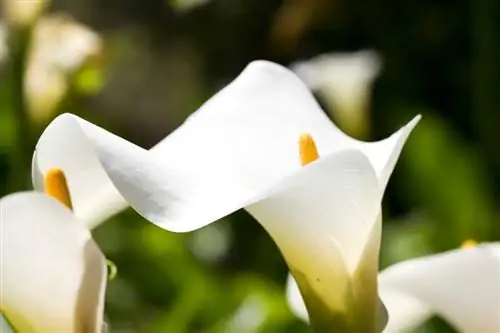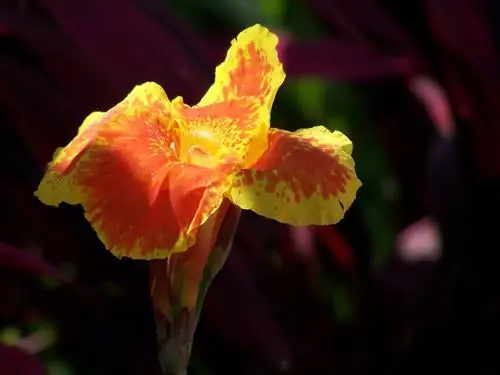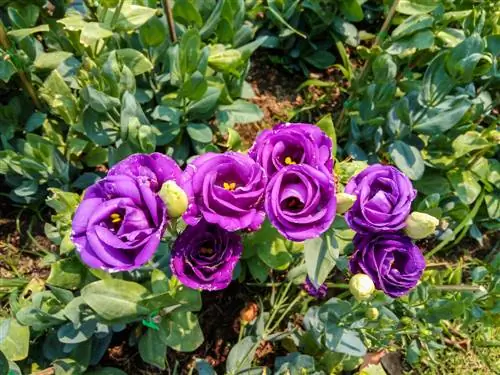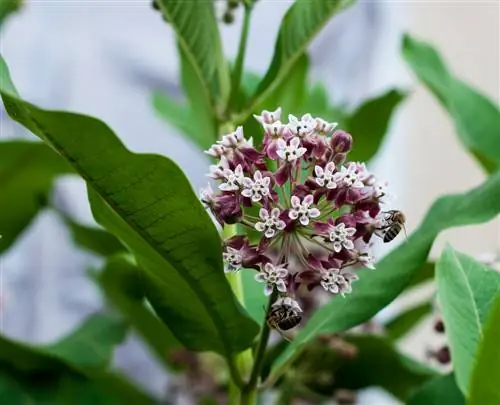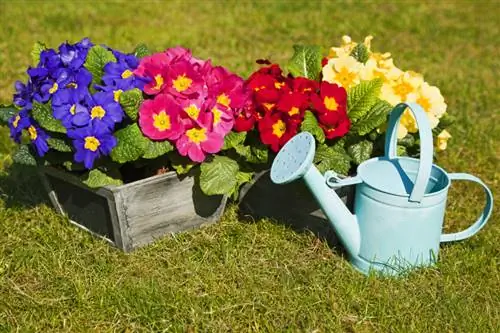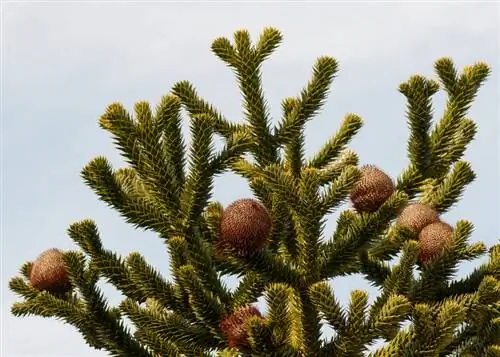- Author admin [email protected].
- Public 2024-01-02 03:03.
- Last modified 2025-01-23 11:22.
With colorful funnel flowers, callas create an exotic ambience on the windowsill and in the garden. Their African origins, the different flowering times and unorthodox facets of their cultivation raise questions about the calla lily, which we answer here in a compact and practical way.
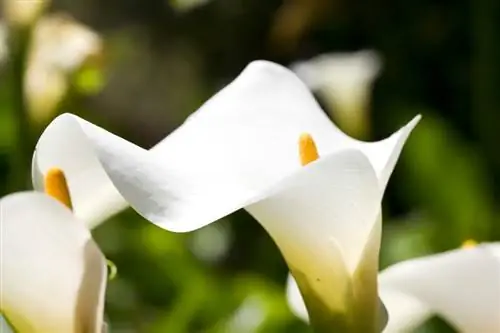
How do you properly care for calla lilies?
Caring for a calla lily includes a sunny location, regular watering during the flowering period, fertilizing every 14 days during growth and weekly during flowering, a dormant period with reduced water supply and annual repotting at the end of the dormant period.
Planting calla correctly
Plant summer-flowering callas in pots with loose substrate in February to prepare them for the coming season. Place an onion no more than 5-7 centimeters deep in the soil and water it in sips. Until mid-May, gradually increase the amount of watering and fertilize every 14 days. After the ice saints, plant the flowers in the sunny bed or the pot (€24.00 on Amazon) on the balcony. Make sure that the tip is directed upwards and that the calla lily does not go deeper than 7 centimeters into the soil.read more
Care tips
Your care is out of the ordinary in some respects. That doesn't mean calla lilies are difficult to grow. If you put together a balanced care package from the following components, the exotic plant will bring you a lot of joy:
- Water callas regularly and abundantly while they are blooming
- From the beginning of budding until flowering, fertilize every 2 weeks, during flowering every week
- At the end of the flowering period, stop fertilizing and gradually stop the water supply
- Winter-blooming calla lily in late summer, repot summer-blooming plant in spring
Callas spend the rest period, which usually lasts 10 weeks, in a cool, bright place. Houseplants can remain in the pot while the flower tubers in the bed are dug up and stored in a dry, frost-free place.
Which location is suitable?
A location flooded with light suits the sunny disposition of a calla lily. However, the flowers do not like to be confronted with the blazing midday sun. The plant appreciates warm temperatures of around 20 degrees in summer, while periods of heat can affect flowering. During the rest phase it can be a little cooler, but free of frost. Callas place these demands on the soil:
- Nutritional, humic and fresh and moist
- In the pot, a compost-based potting soil with a handful of sand
read more
When is flowering time?
The flowering time depends on the variety chosen. The multi-faceted genus features callas that bloom indoors from January to April and flowers that decorate the garden from June to October.read more
Cut calla lilies correctly
Extensive pruning is not necessary on callas. Cut off anything that has faded or withered regularly to prevent rot from forming.read more
Watering calla lilies
Water callas regularly and abundantly during flowering. Under no circumstances should the root ball of this plant dry out during the vegetation phase. After flowering, the water supply is stopped as the flowers take a dry rest period. This is done both for indoor callas and for summer-flowering callas in the garden.read more
Fertilize calla lilies properly
The nutrient supply of a calla lily takes place in three stages. Fertilization is not carried out during the dormant phase. When growth begins, administer a fertilizer for flowering plants every 14 days to shorten the flowering cycle to 8 days.read more
Wintering
The majority of callas are not winter-hardy flowers, so they spend the cold season frost-free. Use, flowering time and type define the professional overwintering of a calla lily. How to do it right:
- Let summer-flowering callas dry in autumn and remove them from the ground
- Remove all leaves and remaining soil
- Store in a bright, cool and, above all, dry place
- Plant in pots with fresh substrate in February and keep warmer
- Plant again in the bed or pot from mid-May (€24.00 on Amazon)
For indoor callas, the growing season begins in early autumn. Give the flowers a bright location at temperatures of 12-15 degrees and water occasionally until the flowering period begins in January.read more
Propagate calla lilies
Like all bulb flowers, the calla lily also develops bulbs. These are ideal for easy propagation. Use the annual repotting to cut off the daughter bulbs with a sharp knife. When planted in loose potting soil, calla lilies develop into magnificent blooms within a short period of time. Sowing seeds, on the other hand, is much more complex and time-consuming.
Repotting
Repotting every year maintains the vitality and willingness to bloom of a calla lily. The ideal time for this care measure is at the end of the rest phase, as the stress factor for the plant is minimal at this time.read more
Calla in a pot
The calla lily is ideal for growing in pots. Here it unfolds its exotic elegance in a sunny location either from January to April or during the summer. Water the plant regularly during flowering and fertilize weekly with a liquid preparation. If the flowering period is coming to an end, stop supplying both water and nutrients. Until next season, keep the bulbs dry, airy and light with or without soil.read more
Is calla lily poisonous?
The assignment of callas to the arum family signals that it is a poisonous plant. In fact, all parts of the plant contain toxic pungent substances. These cause skin irritation on contact and nausea and vomiting if consumed in large quantities. Cultivating calla lilies in close proximity to children and pets is not recommended.read more
Calla doesn't bloom
If your calla lily is not blooming, undertake a dedicated investigation into the cause. Check the site conditions as well as the water and nutrient balance. If the plant comes from propagation by sowing, it takes several years until the first flowering.read more
Yellow leaves
If the leaves turn yellow after flowering, it is a natural process. If yellowing occurs prematurely, check the location, substrate and water and nutrient supply. As a rule, this damage can be traced back to care errors.read more
The calla varieties
If you can't get enough of elegant callas, combine the enchanting varieties that skilled breeders have coaxed out of the different species. The Zantedeschia aethiopica served as the mother plant for numerous indoor callas, which delight us with their tropical colors on the windowsill from January to April. African species such as the Golden Calla (Zantedeschia elliottiana) and the Pink Calla (Zantedeschia rehmannii) produced magnificent flowers that bloom in the garden from June to October.read more
- Sensation: white and purple marbled calla lily with long flowering period from July to October
- Black Forest: impresses in the room and garden with dramatically colored funnel flowers in black from June to September
- Mango: an enchanting plant with orange flowers for the summer flower bed, balcony and windowsill
- Mozart: a flower composition by a master hand for a summery bloom in bright orange
- Pasja: fantastically beautiful eye-catcher in pots and beds with violet iridescent flowers from June to August
- Green Goddess: rare winter-flowering indoor calla with white-green bracts
The calla lily as a houseplant
In order for the calla lily to stay with you as a houseplant, no component of its cultivation must be neglected. This is what the plant values:
- Sunny, warm location on the south or west window
- Keep constantly moist during the flowering period
- Spray every few days with lime-free water
- Fertilize every 14 days during growth, weekly during flowering
At the end of the flowering period, gradually reduce the water supply and stop fertilizing. If the leaves have yellowed, stop watering at all. It is only in early autumn that watering of a calla lily gradually begins again when growth begins.read more
Is calla lily poisonous to cats?
A calla lily poses a risk of poisoning for cats. The arum plant contains poisonous pungent substances in flowers, leaves and tubers which, if consumed, lead to cramps, vomiting and diarrhea.read more
Calla bulbs
The most beautiful callas grow from onions. Plant these in pots with permeable substrate in spring to encourage them to grow. From May onwards you can plant the plant either in the bed, in the large pot or in the planter box. A winter-blooming calla lily serves as a decorative indoor plant when the bulbs are planted in pots in early fall.read more
The leaves of the calla lilies
If the leaves of a calla lily turn yellow prematurely, there is usually a lack of care. Also check the foliage meticulously for pest infestation, such as aphids, spider mites or mealybugs.read more
The flower of the calla
What we admire as a flower on a calla lily is actually a colorful bract. Its job is to attract busy insects to pollinate the actual flower of this plant. This is located in the center of the bract in the form of a yellowish, green or brown piston.read more
The calla shines in many colors
The need for care of callas can be recognized by their colors. A white-flowering calla lily is naturally more robust than flowers in bright colors. So it's no surprise that the only hardy plant in this genus blooms in bright white.read more
The calla lily as a cut flower
A calla lily also works wonderfully as a cut flower. Water the plant thoroughly the evening before. The next morning, cut the flower stems as deeply as possible and secure the end with a little tape so that it doesn't roll up. The flowers last up to 3 weeks in fresh water.read more
Calla seeds
Only hobby gardeners with a lot of patience should grow callas from seeds. When sown in disinfected potting soil, germination takes weeks or even months at 20-22 degrees Celsius. Keep the seeds constantly moist in a partially shaded location. After you separate the seedlings in pricking soil, the future callas go through the wet-dry cycle just like an adult plant. It takes several years before the first flowering occurs.read more
Is the calla hardy?
In general, callas are not hardy. Only a new variety from the Zantedeschia aethiopica section is able to withstand frosty temperatures with adequate winter protection.read more
Is the calla lily hardy?
The vast majority of these flowers are not winter hardy. Native to the warm regions of South Africa, the plant was not forced to adapt to frosty temperatures. Ingenious breeders have now created the first calla lily that can spend the winter in the garden. The Crowsborough variety, which flowers white from June to August, does not need to be shed as long as it receives adequate winter protection.read more
Overwintering the calla lilies in the pot
Summer-flowering callas can overwinter both without soil and in soil. This is how it works in the pot:
- Stop watering and fertilizing after flowering
- Cut off all withered plant parts
- Carry callas in the pot to a cool, bright location
- Make the flowers warmer from January and repot them in February

